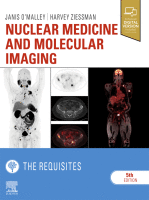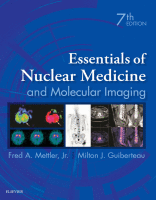Physical Address
304 North Cardinal St.
Dorchester Center, MA 02124

Introduction: The Ventilation–Perfusion Lung Scan Particles slightly larger than red blood cells can be radiolabeled and injected into a peripheral vein. After passing through the heart and central pulmonary arteries, they finally lodge in the peripheral lung capillaries, creating a…

Made up of inorganic calcium hydroxyapatite (Ca 10 [PO 4 ] 6 [OH] 2) crystal and an organic matrix of collagen and blood vessels, the skeleton is constantly changing and remodeling. This physiological activity can be imaged with radioactive analogs…

Molecular imaging (MI) allows noninvasive visualization and quantification of functions occurring at the cellular or molecular level. This can involve several different techniques ( Table 5.1 ), but tagging a targeted probe with a radioactive molecule is one of the…

An unstable atom that undergoes radioactive decay in order to achieve stability is known as a radionuclide. The radiation these atoms emit can sometimes be used in medical imaging and therapy. Agents approved for such uses in humans that incorporate…

Data Acquisition of Emission Tomographyn Conventional or planar radionuclide imaging suffers a major limitation in the loss of object contrast as a result of background radioactivity. In the planar image, radioactivity underlying and overlying the object of interest is superimposed…

The passage of radiation, such as x-rays and gamma rays, through a given material leads to ionizations and excitations that can be used to quantify the amount of energy deposited. This property allows measurement of the level of intensity of…

In nuclear medicine, radiopharmaceuticals given to the patient emit the radiation used to create images or perform therapy. In order to understand how these agents perform and what safety considerations are involved in their use, it is necessary to be…

Spills of Radioactive Materials Accidental spillage of radioactive material is rare; however, spills may occur in the laboratory, in public areas such as facility hallways, in elevators, or in any hospital room or ward through contamination by patient body fluids.…

You’re Reading a Preview Become a Clinical Tree membership for Full access and enjoy Unlimited articles Become membership If you are a member. Log in here

You’re Reading a Preview Become a Clinical Tree membership for Full access and enjoy Unlimited articles Become membership If you are a member. Log in here